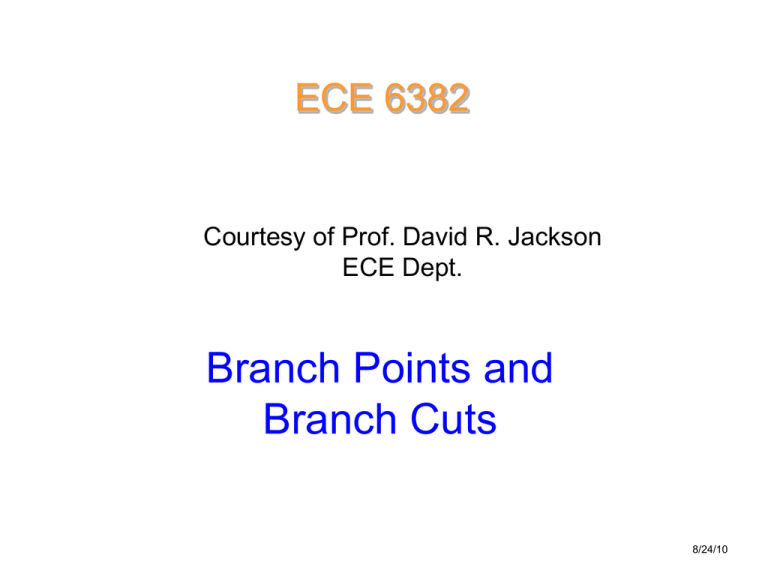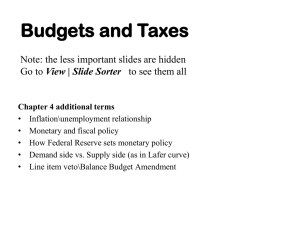Lect5JacksonBranchCutNotes
advertisement

ECE 6382 Courtesy of Prof. David R. Jackson ECE Dept. Branch Points and Branch Cuts 8/24/10 Preliminary Consider f z z1/ 2 1/ 2 z Choose z r 1 r e z r e j j 1/ 2 r e j / 2 0: z1/ 2 1 2 : z1/ 2 1 4 : z1/ 2 1 There are two possible values. Branch Cuts and Points The concept is illustrated for 1/ 2 z f z z1/ 2 re z r e j j / 2 y Consider what happens if we encircle the origin: r=1 C B A x Branch Cuts and Points (cont.) y z1/ 2 r e j / 2 r=1 r C B A point A B C 0 2 x z1/2 1 +j -1 We don’t get back the same result! Branch Cuts and Points (cont.) z1/ 2 r e j / 2 y Now consider encircling the origin twice: r=1 r D C B A point A B C D E 0 2 3 4 E x z1/2 1 +j -1 -j 1 We now get back the same result! Hence the square-root function is a double-valued function. Branch Cuts and Points (cont.) z1/ 2 r e j / 2 y Now consider encircling a point z0 not at the origin increasing B z0 A decreasing x Unlike encircling the origin, now we return to the same result! Only the point at the origin must be encircled twice to return to the starting value. Branch Cuts and Points (cont.) The origin is called a branch point: we are not allowed to encircle it if we wish to make the square-root function single-valued. In order to make the square-root function single-valued, we insert a “barrier” or “branch cut”. y branch cut x Here the branch cut is chosen to lie on the negative real axis (an arbitrary choice) Branch Cuts and Points (cont.) We must now choose what “branch” of the function we want. z r e j 1/ 2 z re j / 2 y branch cut z 1 z1/ 2 1 x Branch Cuts and Points (cont.) Here is the other branch choice. z r e j 1/ 2 z re j / 2 y branch cut 3 z 1 z1/ 2 1 x Branch Cuts and Points (cont.) Note that the function is discontinuous across the branch cut. z r e j 1/ 2 z re j / 2 y branch cut z 1, z1/ 2 j z 1, z1/ 2 j z 1 z1/ 2 1 x Branch Cuts and Points (cont.) The shape of the branch cut is arbitrary. z r e j z1/ 2 r e j / 2 y / 2 3 / 2 z 1 branch cut x z1/ 2 1 Second branch is 3 / 2 7 / 2 Branch Cuts and Points (cont.) The branch cut does not even have to be a straight line z r e j z1/ 2 r e j / 2 In this case the branch is determined by requiring that the square-root function change continuously as we start from a specified value (e.g., z = 1). y z 1 z 1/ 2 j z j z1/ 2 e j / 4 1 j / 2 z 1 x z1/2 1 ( 0) branch cut z j z1/ 2 e j / 4 1 j / 2 Branch Cuts and Points (cont.) Branch points appear in pairs; here one is at z=0 and the other at z= ∞ as determined by examining ζ = 1/ z at ζ=0 z r e j z1/ 2 r e j ( / 2 k ) , k 0,1 1/ 2 1/ z 1/ 2 1 r e j ( / 2 k ) ; k 0,1 Hence the branch cut for the square-root function connects the origin and the point at infinity Branch Cuts and Points (cont.) Consider this function: f ( z ) z 1 2 1/ 2 What do the branch points and branch cuts look like for this function? Branch Cuts and Points (cont.) f ( z ) z 1 2 1/ 2 z 1 1/ 2 z 1 1/ 2 z 1 1/ 2 z 1 1/ 2 y 1 x 1 There are two branch cuts: we are not allowed to encircle either branch point. Branch Cuts and Points (cont.) f ( z) z 1 1/ 2 Geometric interpretation z 1 1/ 2 w1 z 1 r1 e j1 y w2 z (1) r2 e j2 w2 2 w1 1 1 r2 e j2 / 2 x 1 f ( z) r1 e j1 / 2 w11/ 2 w1/2 2 Branch Cuts and Points (cont.) f ( z) z 1 2 1/ 2 z 1 1/ 2 z 1 1/ 2 y 1 1 We can rotate both branch cuts to the real axis. x Branch Cuts and Points (cont.) f ( z) z 1 2 1/ 2 z 1 1/ 2 z 1 1/ 2 y The two branch cuts “cancel” 1 x 1 1 Note that the function is the same at the two points shown. x Branch Cuts and Points (cont.) f ( z) z 1 2 1/ 2 z 1 1/ 2 z 1 1/ 2 Note: we are allowed to encircle both branch points, but not only one of them! y 1 1 An alternative branch cut x Branch Cuts and Points (cont.) f ( z) z 1 2 1/ 2 z 1 1/ 2 z 1 1/ 2 y 4 1 3 2 5 6 1 1 x 7 Suppose we agree that at point 1, 1 = 2 = 0. This should uniquely determine the branch of the function everywhere in the complex plane. Find the angles 1 and 2 at the other points labeled. Branch Cuts and Points (cont.) f ( z) z 1 1/ 2 2 z 1 1/ 2 z 1 1/ 2 y 3 4 1 5 2 6 1 1 7 x point 1 2 1 2 3 4 5 6 7 0 0 0 0 2 2 2 2 Riemann Surface A Riemann surface is a surface that combines the different sheets of a multi-valued function. It is useful since it displays all possible values of the function at one time. Riemann Surface (cont.) The concept of the Riemann surface is illustrated for f z z 1/ 2 z r e j The Riemann surface is really two complex planes connected together. The function z½ is analytic everywhere on this surface (there are no branch cuts). It also assumes all possible values on the surface. Consider this choice: Top sheet: Bottom sheet: (11/ 2 1) 3 (11/ 2 1) Riemann Surface (cont.) x y top D B bottom B D y D B x D B side view top view Riemann Surface (cont.) top sheet branch point branch cut bottom sheet Riemann Surface (cont.) y r=1 connection between sheets D D point A B C D E 0 2 3 4 z1/ 2 1 +j -1 -j 1 r B B C A E z re j f z z1/ 2 ( 1) e j / 2 e j / 2 x Riemann Surface (cont.) f z z 1 2 1/ 2 y escalator 1 x 1 escalator There are two “escalators” that now connect the top and bottom sheets of the surface. Riemann Surface (cont.) top sheet: f z z 1 1/ 2 2 Define by 1 = 2 = 0 on real axis for x > 1 f z 3 y 1 z 2 x 1 f z 3 f ( z) z 1 1/ 2 z 1 1/ 2 bottom sheet The angle 1 has changed by 2 as we go back to the point z = 2. Other Multiple-Branch Functions f z z1/3 r1/3 e j /3 three sheets f z z 4/5 r 4/5 e j 4 /5 five sheets f z ln( z) ln r e j ln r j ln z f z z e ln r j e The power is an irrational number. infinite number of sheets e ln r e j infinite number of sheets






